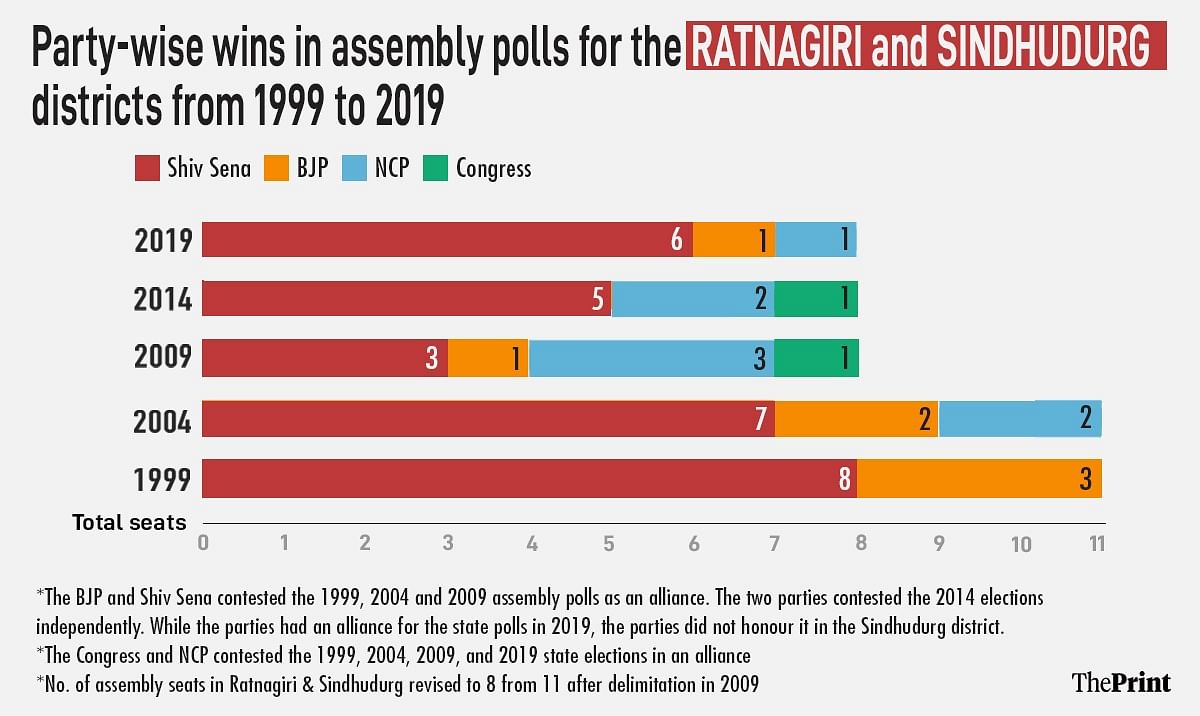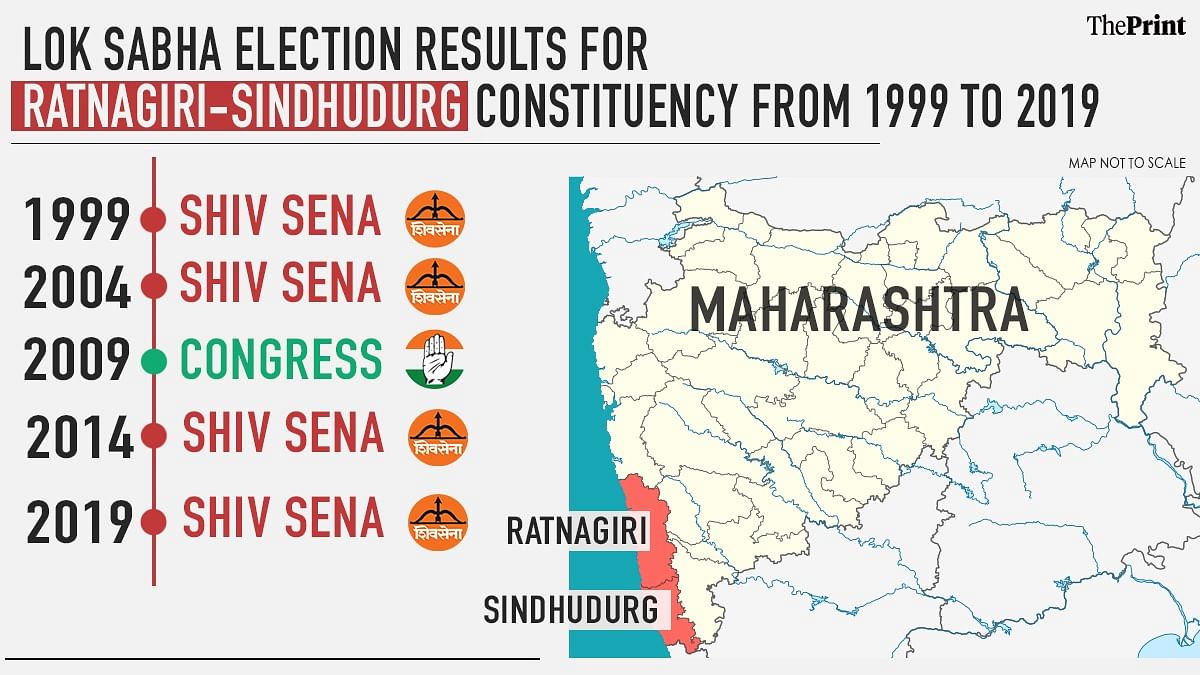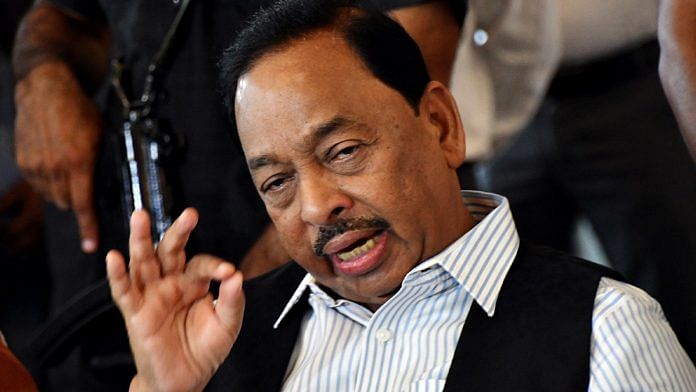Mumbai: Union Minister Narayan Rane was Tuesday denied anticipatory bail, and arrested for his comments about wanting to slap Uddhav Thackeray for what he described as the Maharashtra Chief Minister’s ignorance about India’s independence year, and was granted bail only around midnight.
The day after, sitting at his bungalow in Mumbai’s upscale Juhu suburb, Rane, a former Shiv Sena leader, addressed a press conference, exuding confidence. “I have a big role in the Shiv Sena’s growth. None of these leaders of today were there at the time… None of you (Shiv Sena) can do me any harm. I have proven myself to be more than a match for everyone.”
Statistics, however, do not support Rane’s confidence.
Election data over the past two decades appears to show that Rane, who was once known as a Konkan strongman, is losing his grip over the region. The Konkan region includes the districts of Mumbai, Thane, Raigad, Ratnagiri and Sindhudurg.
Rane, who first became an MLA from Sindhudurg’s Malvan constituency in 1990, was known to wield significant political influence in the district, and to a certain extent in neighbouring Ratnagiri.
He started his political career with the Shiv Sena in the 1970s, quit the party in 2005, and joined the Congress. He exited the Congress in 2017, and started his own outfit — the Maharashtra Swabhiman Paksha — aligning with the BJP. He ultimately merged his party with the BJP in 2019.
An analysis of assembly and Lok Sabha election results for the Sindhudurg and Ratnagiri districts from 1999 shows that neither did Rane’s exit cause the Shiv Sena much harm there, nor did his presence give the parties he joined later — the Congress and the BJP — much of a political advantage.
Political commentator Hemant Desai told ThePrint that the “Shiv Sena was strong in Ratnagiri-Sindhudurg, but Rane’s influence was largely limited to the Sindhudurg district even when he was with the Shiv Sena”.
“But, over time, Rane lost his own assembly constituency there. His son Nilesh lost the Lok Sabha election there (in 2014), and now his clout even in Sindhudurg has considerably reduced.”
Also Read: Congress’ Nana Patole wants to fight solo in Maharashtra, but data says it’s not a good idea
Rane’s journey as an MLA
Narayan Rane was first elected as an MLA from the Malvan assembly constituency. He won the seat again in 1995, 1999 and 2004 as a Shiv Sena candidate.
After quitting the Shiv Sena, Narayan Rane contested as a Congress candidate in the by-election to the Malvan assembly constituency in 2005 and retained hold on the seat, causing the Shiv Sena candidate to lose his deposit.
After the 2009 delimitation, the Malvan assembly constituency ceased to exist and Rane contested from Kudal in Sindhudurg, which he won.

In 2014, the Shiv Sena dislodged Rane from the constituency. Sena’s Vaibhav Naik trounced Rane with a margin of 10,376 votes. Naik held on to the seat in 2019, defeating Independent Ranjit Desai, who Rane had fielded from his Maharashtra Swabhiman Paksha.
In 2015, Rane tried to make a comeback in the Maharashtra legislative assembly by contesting a bypoll from the Bandra East assembly segment, where the Thackeray residence, Matoshree, is located. The seat had fallen vacant after sitting Shiv Sena legislator Bala Sawant died.
The Shiv Sena fielded Sawant’s wife, Trupti Sawant, against Rane and defeated him. In 2016, the Congress accommodated Rane’s ambitions by fielding him for an MLC seat, which he won.
Speaking to ThePrint in 2017, after quitting the Congress and forming his own party, Rane said, “Till 2019 I am here, after that I would like to go to Delhi.”
The BJP fulfilled Rane’s ambitions a little before his plans. In 2018, the party supported him to secure a Rajya Sabha seat, and, three years later, placed him in the Union cabinet.
Also Read: Bal Thackeray set Sena motto as 80% social work, 20% politics, but 6-yr data is another story
Shiv Sena stronger in Sindhudurg-Ratnagiri
Data from past elections shows that, barring the very first Lok Sabha and assembly election after Rane’s exit from the Shiv Sena, the Uddhav Thackeray-led party has only grown stronger in the Ratnagiri-Sindhudurg belt.
In the 1999 and 2004 assembly elections, the Shiv Sena won eight and seven of the 11 assembly seats in the two districts, respectively.
In 2009, following a delimitation exercise, the number of assembly seats in the Ratnagiri and Sindhudurg districts was revised to eight, of which Shiv Sena won three. The party did not win any of the three seats in Sindhudurg (it had contested two). However, its then ally, the BJP, clinched one of the three constituencies in the district.
With Rane in the Congress, the party and its ally, Nationalist Congress Party, picked up the other two Sindhudurg seats — Rane’s constituency of Kudal, and Sawantwadi. That year, the Congress also won the Ratnagiri-Sindhudurg Lok Sabha seat for the first time since 1991 with Rane’s son, Nilesh, getting elected from there. The seat was firmly held by the Shiv Sena from 1996 onwards.
However, in just five years, the Shiv Sena pared its losses in the district. In the 2014 Lok Sabha polls, the party regained the Ratnagiri-Sindhudurg parliamentary constituency, which it defended even in the 2019 polls. The same year, in the assembly election, the Shiv Sena’s performance in the two districts improved to five out of eight seats, and in 2019, six out of the eight seats.

While the BJP has been hoping to increase its presence in the Konkan districts with Rane’s support, in the 2019 state elections, the party’s alignment with the former Maharashtra CM gave it only one MLA — Rane’s son Nitesh from the Kankavali constituency.
(Edited by Sunanda Ranjan)
Also Read: A history of Uddhav Thackeray-Narayan Rane enmity — from ‘kombdi chor’ to ‘ghar kombda’






